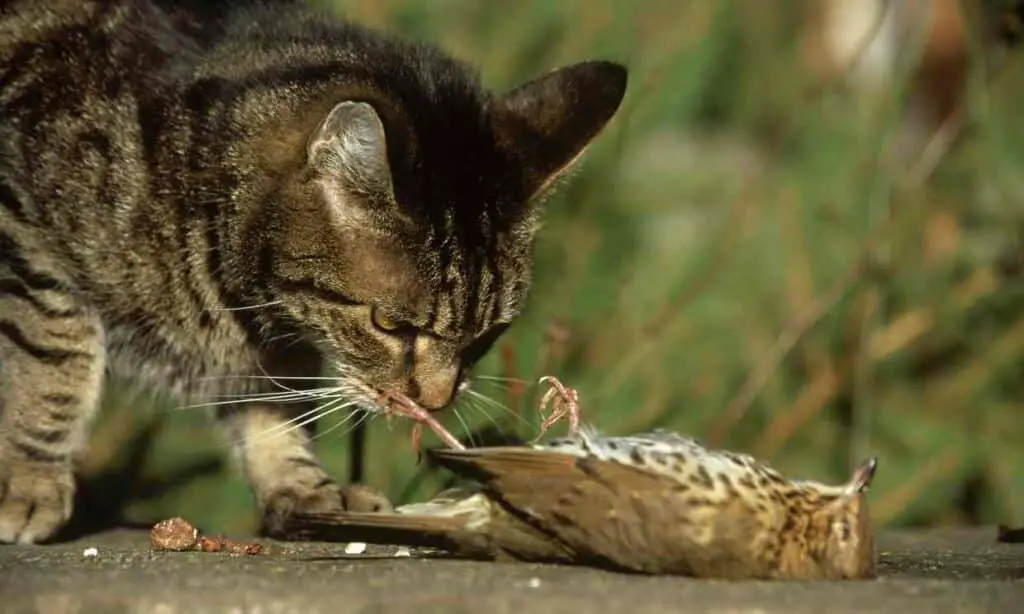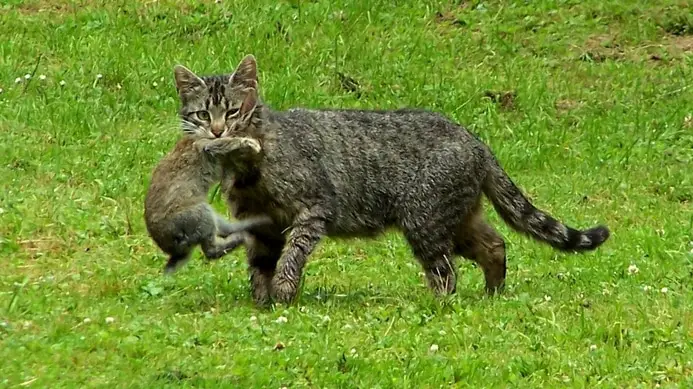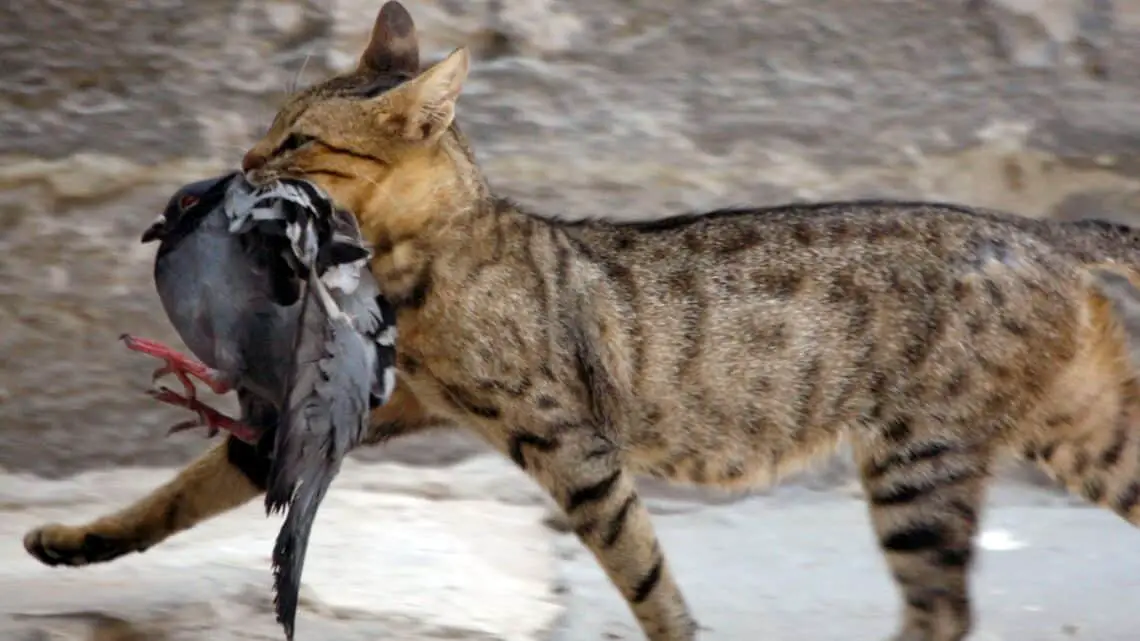Introduction
What Do Cats Eat In The Wild: In the wild, the diet of cats is primarily carnivorous, meaning they primarily consume meat to meet their nutritional needs. Unlike some other animals that can subsist on a more varied diet, cats are obligate carnivores, which means that their bodies are adapted to require a diet composed mainly of animal-based protein sources. This dietary specialization is rooted in their evolutionary history as predators.
In their natural habitats, wild cats food, such as lions, tigers, and smaller species like bobcats and lynxes, hunt and consume a wide range of prey. Their diet typically consists of small to medium-sized mammals, birds, reptiles, and occasionally insects. The nutrients they obtain from these prey items, such as protein, essential fatty acids, and certain vitamins, are crucial for their overall health and survival.
Cats in the wild have evolved to extract most of their water needs from their prey, which is why they may not have the same instinctual drive to drink water as other animals. This is an important adaptation to their often arid and water-scarce environments.
It’s worth noting that the nutritional needs of domesticated cats are not fundamentally different from those of their wild counterparts. Even though they have been living with humans for thousands of years, their digestive systems and nutritional requirements remain largely unchanged. Therefore, when choosing cat food for domesticated felines, it’s important to prioritize high-quality animal-based protein sources that mimic their natural diet.

What do cats naturally eat?
Being true carnivores they survived mainly on fresh small herbivores; rodents, birds and reptiles plus insects, and in the case of large cats, ruminants such as buffalo and deer. A cat will eat the whole of its prey fresh, including entire rabbits (gut contents, offal and nervous tissue included).
Carnivores at Heart
Cats are obligate carnivores, a classification that underscores their biological need for a diet primarily composed of animal-derived nutrients. This evolutionary adaptation developed over millions of years, shaped by their roles as hunters and predators. The anatomy of a cat, including their sharp teeth and digestive system, is well-suited to processing and deriving nourishment from animal tissues.
Wild Cat Diets
In the wild, the diet of various cat species reflects their environments and available prey. Larger felines such as lions and tigers target larger mammals, while smaller wildcats like lynxes and bobcats focus on smaller prey like rodents and birds. This diversity highlights their ability to adapt their diets to survive in different ecosystems.
Nutrient Essentials
The natural diet of cats provides a spectrum of essential nutrients necessary for their optimal health. Protein, vital for muscle growth and repair, is a cornerstone. Taurine, an amino acid found exclusively in animal tissues, is essential for maintaining heart health and promoting proper vision. Cats also require a high amount of dietary fat for energy and absorbing fat-soluble vitamins.
Raw and Whole Prey
In their natural habitats, wild cats consume prey in its entirety – skin, bones, organs, and muscle meat. This whole prey approach ensures a balanced intake of essential nutrients, including calcium and phosphorus from bones, and various vitamins and minerals from organs. Raw consumption retains vital enzymes and nutrients often destroyed by cooking.
What do stray cats eat in the wild?
Cats are carnivorous creatures that regularly hunt for their food. Rodents, birds, fish, and even insects make up a typical cat’s diet in the wild. Feral cats can also subsist on garbage, unattended pet food, and even roadkill.
Variety Amidst Scarcity
Stray cats’ diets are diverse and often dictated by what’s available in their environment. Much like their wild counterparts, these felines consume a range of prey, including small mammals like rodents, birds, insects, and even scavenged scraps. Their diet largely mirrors the opportunistic nature of their lifestyle, where each meal might be different from the last.
Hunting and Foraging
Stray cats tap into their innate hunting instincts to secure food. They rely on their acute senses, stealth, and agility to stalk, pounce, and capture prey. While they might not have the same consistency of success as their wild relatives, they do manage to catch enough to survive. In urban settings, scavenging through trash bins for leftovers also becomes a viable strategy.
Challenges in Urban Landscapes
In urban environments, where stray cats often roam, their food sources become both diverse and unpredictable. They might feed on rodents attracted to garbage, forage for small insects, or even steal from pet food left outdoors. However, these urban meals might not always provide the full range of nutrients required for their optimal health.
Nutritional Adaptations
Stray cats, like all cats, require essential nutrients to thrive. Adequate protein intake is crucial for maintaining muscle mass, while essential fatty acids support healthy skin and coat. Strays might need to be more opportunistic to meet these nutritional needs, consuming a mix of prey to acquire the required nutrients.
Do wild cats only eat meat?
Your cat is a natural hunter, and wild cats eat high amounts of protein from prey. Like their wild ancestors, cats are obligate carnivores because they need diets that consist of high amounts of protein and low fat and carbohydrates.
Obligate Carnivores
Wild cats are classified as obligate carnivores, which means they are biologically adapted to thrive on a diet that consists primarily of animal-derived nutrients. Their anatomy, including sharp teeth for tearing flesh and a short digestive tract for processing protein-rich foods, underscores their evolutionary specialization for meat consumption.
Meat-Centric Diets
Meat, particularly muscle tissue, serves as a rich source of protein, essential amino acids, vitamins, and minerals that wild cats require for their survival and overall health. A diet high in animal protein helps maintain muscle mass, supports immune function, and provides the energy needed for hunting and other activities.
Diverse Prey
While wild cats do predominantly consume meat, the range of prey they target is surprisingly diverse. Their diets are influenced by their habitats and the availability of prey species. Larger cats such as lions and tigers target larger mammals, while smaller wildcats might focus on smaller prey like birds, rodents, and insects. This adaptability allows them to exploit the resources available in their specific ecosystems.
Nutritional Necessities
Wild cats’ meat-centric diets provide them with essential nutrients that are vital for their survival. Taurine, an amino acid found exclusively in animal tissues, is critical for heart and eye health. Essential fatty acids, like arachidonic acid, contribute to skin and coat health. These nutrients are difficult for cats to obtain from plant-based sources.
Whole Prey Consumption
In the wild, wild cats often consume their prey whole. This practice ensures they obtain a well-rounded nutritional profile, including minerals like calcium and phosphorus from bones and vital nutrients from organs. Whole prey consumption mirrors the natural balance of nutrients present in the animals they hunt.
Hydration and Prey
One remarkable adaptation of wild cats is their ability to derive a significant portion of their water needs from the moisture content of their prey. This adaptation is particularly advantageous in arid environments where access to freshwater might be limited.
What is a cats Favourite food?
The cat’s favorite food
Cats love pork, chicken and beef. Beef is the only type of meat that can be given to a cat raw, as long as it is fresh. As well as meat, there are also other foods that your kitten likes to eat, perfect for making him happy on Christmas Day. Salmon and tuna are among the cat’s favorite fish.
Individual Preferences
Just like humans, each cat has its own distinct preferences when it comes to food. What might be irresistible to one cat could be met with indifference by another. Factors such as genetics, early experiences, and exposure to various foods can shape a cat’s palate and determine its favorites.
Protein Power
Cats’ carnivorous nature heavily influences their preferences. Protein, particularly from animal sources, plays a central role in their diet. Meat offers essential amino acids, taurine, and other nutrients crucial for maintaining muscle mass, energy levels, and overall health. High-quality animal protein often ranks high on a cat’s list of favorites.
Texture Matters
Beyond flavor, the texture of food can significantly impact a cat’s preference. Many cats favor foods with a meaty texture that mimics the consistency of prey. Wet cat foods with chunks or shreds can be particularly appealing due to their resemblance to fresh meat.
Aromatic Allure
A cat’s sense of smell is highly developed, and aromas play a crucial role in enticing them towards food. Strong-smelling foods, especially those with meaty or fishy scents, can capture a cat’s attention and evoke excitement.
Variety Adds Spice
Cats are known to appreciate variety in their diets. Introducing a range of flavors can keep mealtime interesting and prevent them from becoming too fixated on a single food. Rotating different protein sources and even trying occasional treats can cater to their curiosity.
Treat Temptations
Treats are often a source of joy for cats. Whether it’s a specially formulated cat treat or a tiny morsel of cooked meat, treats offer a chance to indulge their taste buds. However, moderation is key to maintaining a balanced diet.
Can cats drink milk?
The truth is that most cats are lactose intolerant so giving them cow’s milk can actually cause significant health issues. Milk doesn’t part of necessary cat nutrition and many cats suffer stomach upsets or other related problems because their owner thought that they were giving them a treat.
Lactose Intolerance in Cats
Lactose, a sugar present in milk, requires an enzyme called lactase to be properly digested. Kittens produce this enzyme in abundance as they nurse from their mother. However, as cats grow into adulthood, their production of lactase often decreases, leading to lactose intolerance.
Potential Side Effects
When lactose-intolerant cats consume milk or dairy products, they can experience gastrointestinal distress. Symptoms may include stomach upset, diarrhea, bloating, and flatulence. These unpleasant effects stem from the undigested lactose fermenting in the gut, leading to discomfort.
Kittenhood and Milk
It’s important to note that kittens do benefit from their mother’s milk during their early stages of life. Mother cat’s milk provides essential nutrients, antibodies, and sustenance that aid in their growth and development. However, once kittens are weaned and transition to solid food, their ability to digest lactose diminishes.
Exceptional Cases
While many adult cats are lactose intolerant, there are exceptions. Some cats retain the ability to digest lactose without issue. However, these cases are relatively rare. If you’re unsure about your cat’s lactose tolerance, it’s best to consult your veterinarian before offering milk.
Alternatives to Cow’s Milk
If you’re looking to treat your cat to a milk-like experience, there are specially formulated cat milk products available in pet stores. These products are often lactose-free or have reduced lactose content, making them a safer option for cats. These alternative options can provide a creamy treat without the potential for digestive upset.
Do cats eat lizards?
Both dogs and cats are known to catch and eat lizards. Cats can be affected by a parasitic liver fluke due to eating a lizard. Lizards can harbor bacteria that puts dogs and cats at risk of infection. To prevent cats from eating lizards, keep them indoors and secure your patio doors.
Natural Instincts
Cats are instinctual hunters, driven by their innate predatory behaviors. This behavior is rooted in their evolutionary history as solitary predators that relied on hunting for survival. The stalking, pouncing, and capturing behaviors that cats exhibit when chasing toys or insects are echoes of their hunting instincts.
Hunting Rituals
When cats encounter lizards, they often can’t resist their instincts to chase and capture. Lizards’ swift movements and tendency to dart and hide can trigger a cat’s predatory response, making them irresistible targets for feline play or pursuit.
Lizards as Prey
Cats view lizards as small, moving creatures that fit their predator profile. While domesticated cats might not rely on hunting for sustenance, the drive to capture small, evasive prey remains strong. Lizards are not only potential sources of entertainment for cats but also a reflection of their natural behaviors.
Feeding Behavior
Cats that successfully catch lizards might indulge in their catch, consuming the prey either partially or entirely. This behavior is linked to their carnivorous nature and their preference for animal-based protein sources. While lizards may not be a staple of a cat’s diet, their consumption aligns with cats’ evolutionary history as carnivores.
Harm to Lizards
While cats’ hunting behaviors are instinctual, they can have implications for local lizard populations. In certain areas, particularly where lizards are common, cat predation might have minimal impact. However, in regions with endangered or vulnerable lizard species, the presence of outdoor cats can pose a threat.
What food makes cat happy?
Cats are ‘obligate carnivores,’ meaning that meat is a non-negotiable part of their diet. Keep your cat happy and healthy with hearty meals that include meats like chicken, turkey, and duck. Both cats and dogs only produce a fraction of the omega-3 that they need to maintain a healthy and balanced ratio of fatty acids.
Quality Animal Protein
Cats are obligate carnivores, and their bodies thrive on animal-derived protein. High-quality protein sources like chicken, turkey, beef, and fish are not only delicious to cats but also provide the essential amino acids they need for muscle maintenance and overall health. Foods rich in protein can spark delight in a cat’s palate.
Palatability and Aroma
A cat’s sense of smell greatly influences their enjoyment of food. Strong-smelling foods, especially those with meaty or fishy scents, can capture a cat’s attention and create anticipation. Foods that emit appetizing aromas can contribute to their happiness during mealtime.
Variety in Flavors and Textures
Just like humans, cats appreciate variety in their diet. Offering different flavors and textures can keep meals exciting and prevent them from growing tired of a single type of food. Wet cat foods with chunks, shreds, or gravies can add diversity to their culinary experiences.
Safe Treats and Occasional Indulgences
Treats are the culinary equivalent of pampering, and many cats relish the opportunity to indulge. Providing safe and specially formulated cat treats in moderation can add a touch of delight to their day. However, it’s important to ensure that treats are nutritionally balanced and appropriate for their health needs.
Can cats eat biscuits?
Technically, cats can eat human biscuits in moderation, but it’s not recommended as, like any other bread products, they are full of carbs and empty calories that will make your kitty pile on the pounds and contribute to nutritional deficiencies in the long term. So, better not feed your cat biscuits.
Cat-Safe Ingredients
Some plain and simple biscuits might contain ingredients that are not harmful to cats. For instance, plain wheat-based biscuits with minimal additives could be safe for your cat to nibble on occasionally. However, biscuits with complex flavors, seasonings, or added sugars can be problematic for cats.
Moderation is Key
Even if a particular type of biscuit is deemed safe for cats, moderation remains crucial. Biscuits are not a natural part of a cat’s diet and are generally not formulated to meet their specific nutritional needs. Feeding too many biscuits, especially those high in carbohydrates or sugars, can contribute to weight gain and other health issues.
Consideration for Health
Cat owners should prioritize their pets’ health and well-being when selecting treats. Instead of sharing human biscuits, consider offering specially formulated cat treats that are designed with feline nutritional requirements in mind. These treats are typically balanced to provide optimal nutrients without the risk of harmful ingredients.
Hidden Dangers
Some biscuits might contain ingredients that are toxic to cats. For example, certain biscuits might include chocolate, raisins, or xylitol, all of which can be dangerous or even fatal to cats. Always check the ingredient list to ensure the biscuit is safe for feline consumption.

Conclusion
In the wild, the dietary habits of cats are deeply rooted in their evolutionary history as obligate carnivores. Their survival and well-being are dependent on a diet primarily composed of animal protein sources. From large wild cats like lions to smaller species like bobcats, these felines hunt and consume a diverse range of prey, including mammals, birds, reptiles, and insects. Their bodies are adapted to extract essential nutrients from these prey items, such as protein, essential fatty acids, and vitamins. This natural diet is a crucial element in maintaining their health, energy levels, and overall fitness within their ecosystems. As such, understanding the carnivorous nature of wild cats provides valuable insights for the appropriate nutrition and care of our domesticated feline companions.




No Comments